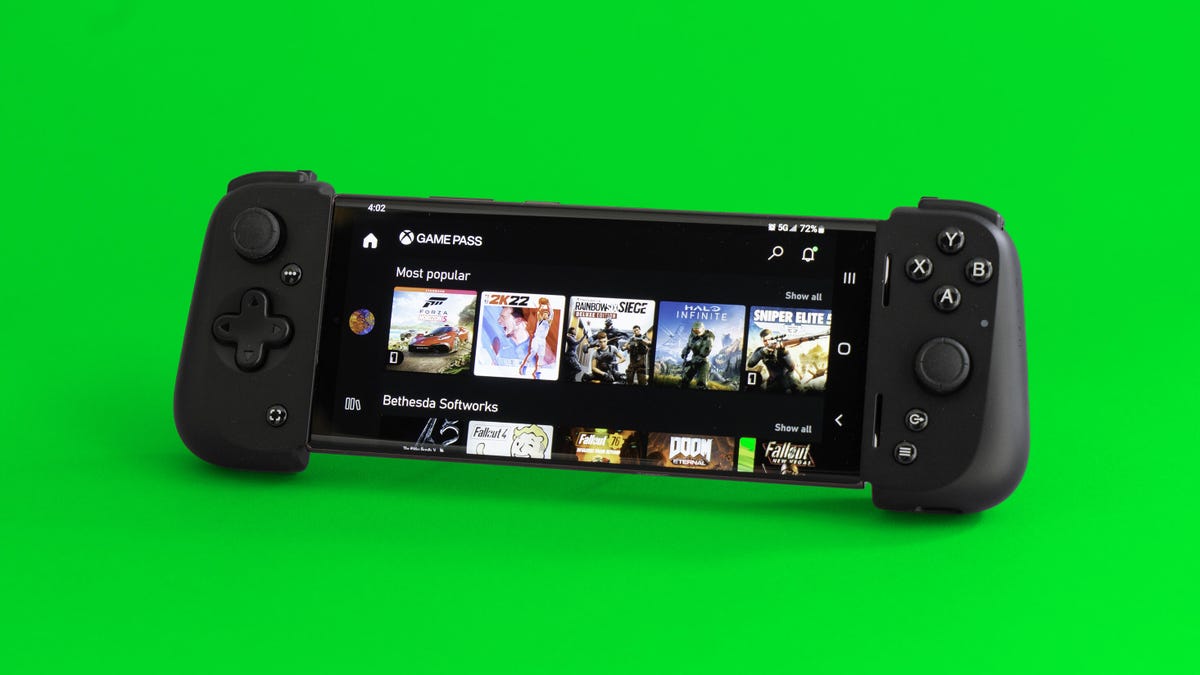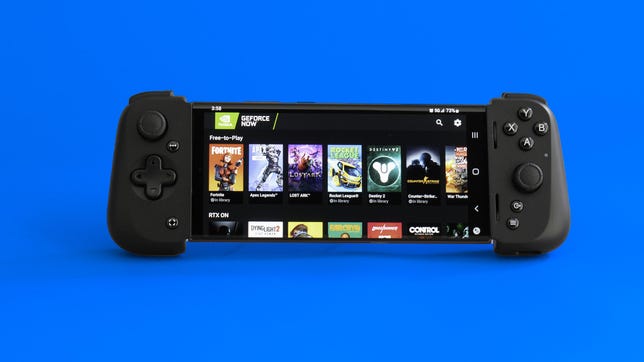 Why You Can Trust CNET
Why You Can Trust CNET Razer Kishi V2 Review: Android Game Controller Goes From Good to Great
Much improved over the original, the Kishi V2 has a smarter, more responsive design that levels up its game.

Since launching the Junglecat in 2019, Razer has been refining the design of its on-phone, Joy-Con-like game controllers. The original Kishi, which succeeded the Junglecat, was a big leap forward thanks to a more Xbox-typical control layout, but its feel and mounting design left something to be desired -- especially once the Backbone One came out for the iPhone. With its second generation of the controller, the Kishi V2, Razer successfully addresses its predecessor's drawbacks by swapping membrane-activated for switch-based buttons and a smart, flexible new mounting design that seems awfully similar to the Backbone's.
The changes turn the controller from the best-of-a-meh-lot in 2020 to a truly recommendable one for your mobile gaming in 2022. One good enough that I manage to forget for long stretches that it is intended for mobile gaming.

Razer Kishi V2
Like
- Controls feel more responsive than a lot of alternatives
- Easy on/off phone mounting design
- Nexus app lets you remap buttons and link to Facebook or YouTube for streaming
- Two programmable buttons
Don't like
- Allows passthrough charging, but you lose audio and fast charging support
- Grips could be a bit larger and grippier
- App needs work
The Kishi V2 is currently available for Android phones with USB-C connections; Razer has verified compatibility with many Samsung Galaxy models (generations S9 or later), Google Pixel (Pixel 2 or later) and its own Razer phones. It doesn't preclude other models working, though. The company plans to release an iPhone-compatible model in the fall; my money's on it arriving around the same time as the iPhone 14. Pricing runs $100, which feels kind of high side for a mobile controller but is about what these phone-mountable designs tend to cost.
The Kishi's pads use tension to attach to the phone and connect via USB-C, which removes the latency and lag of a Bluetooth connection, and means the controller doesn't require charging.
The Kishi is essentially a split Xbox-layout controller with a plastic expander connecting the two sides. You slip your phone in, plugging the USB-C port into the matching connector, and pull the left side to match the top of the phone, which is kept in place by the tension and the plastic bridge. The controller draws power from the phone, though it doesn't seem to pull a lot, and uses USB-C for low-latency response (relative to Bluetooth).
That's how it accommodates phones of varying sizes, and interchangeable rubber gaskets adjust for the thickness of the different phones. This design makes it much easier to put on and take off than the previous one, yet it still feels pretty secure. Unfortunately, my phone case recesses the Galaxy S22 Ultra's USB-C socket too far for the controller connection to reach, but with a thin enough case you might be okay.
At launch, the controller only has confirmed compatibility with Xbox Game Pass Cloud Gaming, Nvidia GeForce Now and Google Stadia, plus local streaming via Steam Link, Xbox Remote Play, Parsec and Moonlight.
In addition to triggers and bumpers at the top, there are small, mappable buttons. I like having extra buttons, because I like to avoid having to click via the thumbsticks, which for me usually results in unwanted movement instead. The tradeoff is the triggers are on the small side, though they don't feel too small and are recessed sufficiently that you won't hit them when reaching for the buttons. And they have nice tension, better than some full-size controllers I've used.
I have to laugh, though. In my review of the original Kishi, I said the thumbsticks felt a little too tight; now it feels like they're a little too loose, or maybe "twitchy" should be the appropriate adjective. Well, I'm pretty hard to please and your thumbs are different than mine. As ever, try before you buy if at all possible.
The grips should feel thick enough if you're used to flat, Joy-Con-like paddles, but if you prefer the solid heft of a traditional controller they can feel a little too unsubstantial at first.
The other controls feel responsive and clicky like a good standalone controller's, though, including the D-pad where even the Backbone One falls short. I like my grips a little thicker, but they're pretty easy to get used to. But despite the textured plastic on the underside, I think they're a bit slippery, especially given the lack of heft. Your mileage may vary.
There's a USB-C passthrough connector on the bottom of the right grip which lets you charge your phone while you're playing or without removing the controller. It doesn't support audio -- disappointing, but not uncommon -- and it doesn't seem to support fast charging, either.
See also
Like Backbone and Gamevice, Razer has an app called "Nexus." It allows you to rebind your controls globally, which is nice, but otherwise is pretty uninspiring. It's not great at managing your games: It only works with those installed on your phone, you can't organize favorites and its discovery suggestions are lackluster.
Plus, it has bad Android etiquette, which I hope is just a prerelease bug; for instance, the only way I could unload was via the OS' force stop command, and the reason it resides in memory is to record all your screens. That may be fine if you plan to use it for streaming (it can connect directly to YouTube and Facebook for that), but kind of disturbing if you don't.
With version 2, the Razer Kishi has become a great mobile game controller, at least for Android phones. How it will integrate with the iPhone remains to be seen. And I look forward to seeing it.

